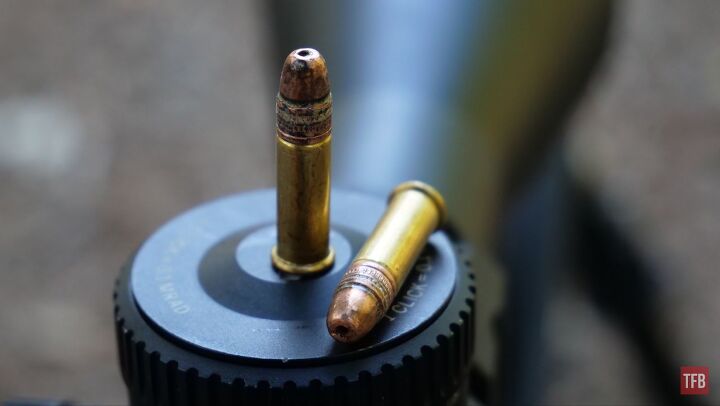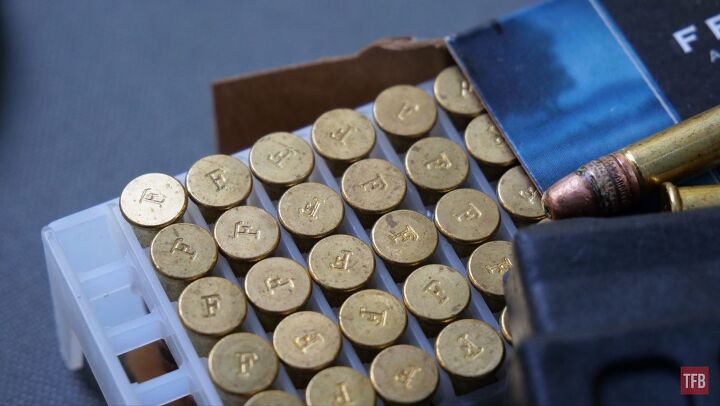The Rimfire Report: Federal Game-Shok 38gr CPHP 22LR

Hello and welcome back to another edition of The Rimfire Report! This ongoing series is all about the rimfire firearm world and its many different types of guns, shooting sports, ammunition, and history! Last week we covered Ruger’s first-ever firearm, the Standard .22LR pistol. While the pedigree of the Ruger Standard pistol is still cherished today, as many of you pointed out, the pistols were pretty unreliable and inaccurate back in the day - modern examples are a much better example of what Ruger was probably going for upon the initial release of the Standard. Today and over the rest of the year we will be getting back into ammunition testing - both in Clear Ballistic gelatin, and also through chronographs and one type of rifle to give you guys a general idea of the performance you can expect from every kind of ammunition. To kick off this new set of ammunition tests we’ll first be testing Federal’s Game-Shok 38-grain Copper Plated Hollow Point 22LR Ammunition. This ammunition from Federal claims to be suitable for hunting small game and should provide the user with an “accurate and consistent” load for shot-to-shot accuracy on presumably squirrel-sized targets.
More Rimfire Report Articles @ TFB:
The Rimfire Report: Federal Game-Shok 38gr CPHP 22LR
Product Link: https://www.federalpremium.com/rimfire/federal-small-game-and-target/game-shok/11-712.html
Product Overview
Whether you're after bushy tails or bunnies, you'll put more in your bag with Federal® rimfire Small Game loads. They offer consistent, reliable performance, yet are affordably priced to keep you in the field for less.
Accurate and consistent
Ideal for small game
High velocity
Caliber: 22 LR
Grain Weight: 38
Muzzle Velocity: 1260
Bullet Style: Copper Plated Hollow Point
Ballistic Coefficient: .131
Package Quantity: 50
Usage: Small Game
Federal Game-Shok comes in at a per-box price of $5.99 which when compared to CCI Standard velocity 40-grain is a whole $1 more per box. This is an understandable price increase provided that the accuracy and consistency claims are true and that it cycles reliably out of your firearm. While my primary test platform for accuracy and velocity testing will be the Bergara B14R, I am considering running a bog-standard ruger 10/22 alongside it for semi-auto testing purposes. I figure a 50-round box reliability test along with the 50-round accuracy and velocity testing should give us all a pretty well-rounded understanding of how each cartridge will perform in a general sense.
Velocity Testing Data
For velocity testing, I chose to use fellow writer Lucas D’s Garmin Xero C1 Pro chronograph. We ran 5 consecutive magazines through the B14Rs 18-inch barrel fitted with a TiOn Inc Dragoon 450B Suppressor. Federal Game-Shok 38-grain CPHP has an advertised velocity of 1,260 fps. Our velocity testing yielded a slightly higher average velocity of 1309.5 fps over a 50-round box. Our extreme spread was 90.5 FPS and the round featured a standard deviation of 17.4 fps - not bad at all for a fairly inexpensive varmint-hunting ammunition.
I had initially thought that the velocity data would be either about the same or slightly below the advertised velocity and was surprised to see that our 18” barrel gave us a slight increase instead. This probably means that Federal might have decided to advertise velocity data as fired from a much more common 16” barrel like what would be found on your typical 10/22 carbine from Ruger. If we take data from the website Ballistics By The Inch, we see that’s not uncommon for .22LR ammunition to jump up in velocity by about 30-50fps with just a 2” increase in barrel length.
I would say that this ammunition earns the “consistent” claim, as while there were a few shots that fell well above or below that average velocity, it wasn’t so many rounds that our standard deviation ballooned above 20-25 fps which is the threshold I consider to be “good” for factory ammunition standard deviation. While it would be great to have an extreme spread that wasn’t edging towards 100 fps, I think for $6 a box you’re getting a decently consistent load for pest control duty.
Accuracy
For accuracy testing, we used a 1” sight-in target set out at 50 yards and shot 10-round groups back to back as we recorded the velocity data. Groups were shot left to right top to bottom with the exception being the larger center diamond which we always shoot last. Out of the 5 groups of 10, our best group was slightly less than 1” in size even with two shots falling outside of the main grouping. While I did have Lucas spotting for me, he was really just enjoying the view and providing encouraging commentary throughout the process rather than giving me wind and shot calls.
Some of the other groups were significantly larger, about 1.5 to 2” in diameter. Part of this I will attribute to eye fatigue - shooting 5 back-to-back 10-round groups through a cheap Vortex Venom 5-25x56 on max magnification really does wear out your eye. I’ve made it a personal goal to get some better glass on the gun for this type of testing. The other component of the larger groups would obviously be the extreme spread we noticed in the velocity testing data. A nearly 100-fps variance in velocity is going to give you some wild vertical stringing which is what I think you’ll observe if you take a look at each of the targets with larger groupings - they all seem to share vertical stringing and we could actually hear the difference in the report of some of these shots because of the slightly different powder loads.
As far as a grade, I’ll give Federal Game-Shok 38gr a pass in the accuracy department as well, especially considering this is a small game-hunting round at the end of the day. Each one of those groups we shot on paper at 50 yards is easily within the realm of squirrel or ground hog-hunting accuracy territory.
Final Thoughts
I really don’t have much negative to say about Federal Game-Shok 38-grain perhaps aside from the extreme spread. However, I can add one more positive in that the round is fairly clean for a rimfire cartridge. A lot of this has to do with the copper plating, but I also find that higher velocity ammunition in a bolt-action gets a much better burn out of the powder leading to less fouling. While the main benefit of copper plating is a cleaner bore and action, the copper also provides a bit of lubricity and this lubricity should lead to better function inside of semi-auto firearms. The next time we take Game-Shok out to the range, it will be to test its terminal effects in clear ballistic gelatin. I’d love to hear your thoughts on today’s test results and your thoughts about how Federal Game-Shok might perform in the ballistic gelatin! Is Federal Game-Shok 38-gr CPHP worth the extra $1 per box over Standard Velocity? Let me know your thoughts in the comments below and as always thanks for stopping by to read The Rimfire Report and we’ll see you all again next week!
Federal Game-Shok 38gr CPHP 22LR Ammunition
We are committed to finding, researching, and recommending the best products. We earn commissions from purchases you make using the retail links in our product reviews. Learn more about how this works.

Reloader SCSA Competitor Certified Pilot Currently able to pass himself off as the second cousin twice removed of Joe Flanigan. Instagram: https://www.instagram.com/ballisticaviation/
More by Luke C.





















![[SHOT 2024] Pedersoli 86/71 Droptine Goes Retro](https://cdn-fastly.thefirearmblog.com/media/2024/05/16/14529535/shot-2024-pedersoli-86-71-droptine-goes-retro.jpg?size=350x220)



![[SHOT 2024] New Khan Arms Matrix Semi-Auto and PXS Pump Action Shotguns](https://cdn-fastly.thefirearmblog.com/media/2024/05/16/14526460/shot-2024-new-khan-arms-matrix-semi-auto-and-pxs-pump-action-shotguns.jpg?size=350x220)




![[SHOT 2024] Falkor Defense Goes Big-Bore](https://cdn-fastly.thefirearmblog.com/media/2024/05/16/14527657/shot-2024-falkor-defense-goes-big-bore.jpg?size=350x220)
![[SHOT 2024] Detroit Gun Works Hitsville and Sherwood Rifles](https://cdn-fastly.thefirearmblog.com/media/2024/05/16/14526319/shot-2024-detroit-gun-works-hitsville-and-sherwood-rifles.jpg?size=350x220)

![[SHOT 2024] TBX Muzzleloader Quick-Charge Systems](https://cdn-fastly.thefirearmblog.com/media/2024/05/16/14529727/shot-2024-tbx-muzzleloader-quick-charge-systems.jpg?size=350x220)
Comments
Join the conversation